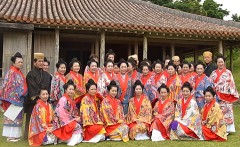Students complete a course in Okinawan traditional dress-fitting and hair-arrangement

The graduation ceremony for the students of the ryuso and karajiyui course of the Ryusogakuin was held on April 9 at the Shikinaen in Naha.
April 12, 2012 Ryukyu Shimpo
On April 9, at the Shikinaen garden in Naha, the Toshiko Chinen Ryubu-dojo and Ryusogakuin Institute held a graduation ceremony for students who had completed the course in ryuso and karajiyui or Okinawan traditional dress and hair-arrangement. At the course, the students can master techniques of the ryuso fitting and karajiyui fixing to make use of them in looking for jobs. The central government supports the course with funding as a vocational training project. Twenty-nine students received certificates of completion, which are level three and higher for half a year’s study, from Toshiko Chinen the president of the institute.
According to the Ryusogakuin, this is the first time that the government has supported vocational training for traditional cultural assets, with its main support for job training being for personal computer training courses. The students taking the course are unemployed workers who do not receive unemployment benefits. This project is supported by the government and certified by the Central Vocational Ability Development Association and involves free tuition. About ten students who completed the course have found jobs in beauty parlors.
Kanako Kamiya said, “I have learned ryubu (Okinawan traditional dance) and I attended this job training course because I want to master ryubu in future. I would like tourists who have never experienced Okinawa traditional dress to do so.” Kamiya said that she is keen to work in the Okinawan tourism industry and Junji Kinjo, one of three male students, said, “I used to run a bike shop, but attended the course because I wanted to try something new as I entered middle-age. The more I studied, the more I realized how much was involved.” Kamiya says that he wants to run his own shop in future.
Yuri Ikeda, the director of the institute commented, “In Kyoto, tourists enjoy dressing up as a maiko or dancing girl and walking around and taking photographs in the street. Similarly, we need people for ryuso and karajiyui to promote Okinawan tourism.”
(English translation by T&CT, Mark Ealey)
Previous Article:History book on human rights in Okinawa published
Next Article:Sakatas close their domestic study program the Warabiya and move to Ogimi
[Similar Articles]
- Joseph Kamiya wants to carry the future of the Okinawa Association of America
- Ryukyu-Okinawa traditional arts group performs in Germany to promote Okinawa tourism
- Okinawa to provide more multi-lingual diving guides
- Okinawa Association of Bolivia holds New Year’s party
- Okinawa tourism generates 1 billion yen in fiscal year of 2015
 Webcam(Kokusai Street)
Webcam(Kokusai Street)


